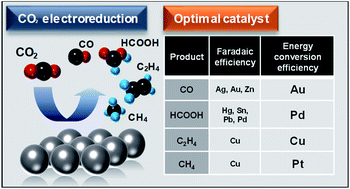Energy conversion efficiency comparison of different aqueous and semi-aqueous CO2 electroreduction systems†
Abstract
An energy conversion efficiency index, that is independent of the anode reaction performance, is proposed for CO2 reduction in aqueous and semi-aqueous systems. The energy conversion efficiency of CO2 reduction under 107 typical conditions was calculated based on the derived formula. Notably, the resulting efficiency trends of the reduction products differed from their faradaic efficiency trends. When the products were CO, HCOOH, C2H4, and CH4, the electrocatalysts with the higher energy conversion efficiencies were Au, Pd, Cu, and Pt, respectively. Based on the discussion on the overall energy conversion efficiency of all products, Pt should be a specific energetically advantageous catalyst for CO2 reduction because the activation energy is negligibly small. Moreover, the energy conversion and faradaic efficiencies were discovered to not only depend on the electrocatalyst species, but also on the complexity of the reaction, including the number of reaction electrons. Our proposed method for evaluating the energy conversion efficiency of cathode reactions can potentially serve as a novel platform for comparing the CO2 reduction efficiencies of different electroreduction systems.

- This article is part of the themed collection: Analytical Methods HOT Articles 2022


 Please wait while we load your content...
Please wait while we load your content...